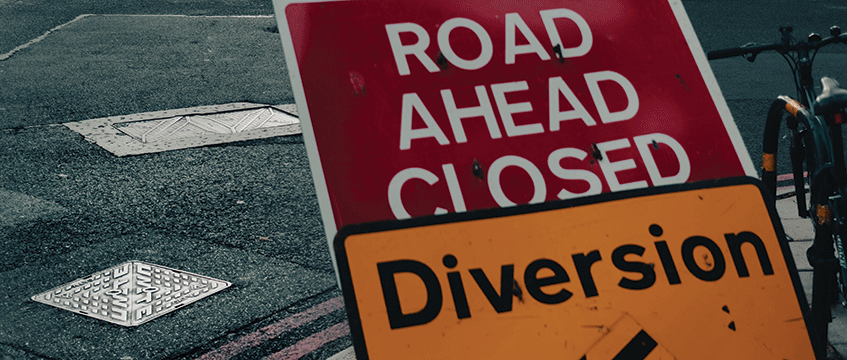Part 1 of this article was our theory test – we looked at the nature of easements, their different types, and the ways in which they are created. In part 2, we get behind the wheel and look at the process of both discovering and asserting the benefit of an easement, and challenging the burden of an easement (with a focus on prescriptive easements).
Part 1 introduced the concept of easements with an example of two retail units sitting on adjoining pieces of land: Land A and Land B.
Owners of Land A are determined to keep full access over the existing road to the rear of their unit for their delivery trucks as this is crucial for the operation of their business. Owners of Land B are determined to proceed with the extension to their unit as this is essential for growth, the road being the only space for the unit to expand onto.
There are clear but competing commercial interests driving both parties to secure superior rights in respect of the road. Owners of Land B are the freehold owners of the land which includes the road. But what if the owners of Land A are able to assert an easement in the form of a right of way over the road?
Asserting easements
Assuming the two pieces of land are registered, the first step for the owner of Land A is to consult the registers of title of Land A and Land B.
Land A’s register of title may, for example, include an entry on the property register which reads: “the land has the benefit of rights granted by a conveyance of the land tinted blue on the title plan dated 1 January 1930.”
Land B’s register of title may then include an entry on the charges register which reads: “the land is subject to the rights excepted and reserved by a conveyance dated 1 January 1930.”
The next logical step is therefore to obtain a full copy of the conveyance dated 1 January 1930 to ascertain the exact nature and extent of the rights and easement which benefit Land A. Owners of Land A would hope that this investigation reveals an express right of way for the benefit of Land A over the road on Land B.
If an investigation of the registers of title does not reveal any entries to indicate the existence of an easement, easements may still be found to have been granted in past conveyances and transfers of Land A and Land B.
If an unregistered easement is found, it will only operate as an equitable easement as legal easements need to be registered (or, in some cases, can operate as overriding interest under the Land Registration Act 2002).
If no express right of way can be shown to benefit Land A, the owners of Land A then have to consider whether they are able to demonstrate an easement by implied grant. We discussed the three ways in which a grant of an easement may be implied in part 1.
In the absence of an express or implied easement, the owners of Land A will have to consider whether there is a strong case to argue that an easement has arisen by prescription. The burden of proof is on the owners of Land A. Owners of Land B will in turn want to dispute that case.
Taking in turn the three requirements for the creation of a prescriptive easement which we introduced in part 1:
i) Is there evidence the road has been used for access for over 20 years? Let us assume the current owners of Land A have owned Land A for the past 10 years and have, in that time, used the road on a regular basis for their deliveries. They are 10 years short of the required evidence of use. However, as discussed in part 1, an easement is a proprietary interest.
So if the previous owner of Land A also used the road on Land B for 10 years or more, that use will count towards the creation of the prescriptive easement. Owners of Land A may therefore wish to get in touch with the previous owner in the hope that they will provide a detailed statement as evidence of long use.
Owners of Land B may be in a better position to present evidence if they had been in occupation of Land B for the entire 20 years of claimed use. For example, they may be able to show evidence of the use having been interrupted at some point before 20 years of use accrued (eg because of works to the road which created an obstruction to the right of way for a sufficient period of time).
ii) Was the road used for access by owners of Land A against the owners of Land B? If Land B was let to a tenant during the period of long use, owners of Land B may use this as an argument against the creation of a prescriptive easement. However, a prescriptive easement will not be defeated if the use by Land A began before Land B was let. So owners of Land A may wish to find evidence of long use going as far back as possible (and beyond the minimum 20 years).
If, at some point during the claimed use, owners of Land B also temporarily owned Land A (or were a tenant of Land A), the unity of ownership or occupation will serve to defeat the prescriptive easement claimed by Land A.
iii) Was the road used by owners of Land A “as of right”? Both sets of owners must think carefully about the circumstances in which the road was used.
For example, have the owners of Land B at any time in the 20 years of use complained to the owners of Land A about the latter’s use of the road? Have they asked owners of Land A to only use the road at certain times of the day where it would not conflict with Land B’s use of the road? Did Land A’s delivery trucks have to pass through a “private road” sign when entering the road? These factual matters may influence whether or not the use of the road was done without force, without secrecy, and without permission.
Having gone through the trouble of asserting both the existence and extent of a right of way for themselves, what can the owners of Land A then do to prevent the proposed obstruction of the road with the extension to Land B?
First, they will have to demonstrate a “substantial” interference to their right of way by the owners of Land B. This requires a court to consider whether, in the circumstances, it is reasonable for the owners of Land A to insist on being able to use the whole of their easement. In the event of a substantial interference, owners of Land A may then apply to court for a remedy, ideally an injunction to prevent the obstruction.
Challenging easements
What can the owners of Land B do to ensure they can erect their extension over the road without the risk of action against them by owners of Land A?
The most obvious way of extinguishing an easement is by express release made by deed. This requires owners of Land A and Land B to agree to permanently release the easement (something which the owners of Land A are unlikely to agree to in our scenario).
Owners of Land B may attempt to negotiate a mutually acceptable solution which may or may not involve an express release of existing easements (eg by sourcing an alternative access route perhaps and financial compensation), but the willingness of the owners of Land A to consider such solutions will depend on the strength of their claim to an existing easement.
Other than negotiating an express release, owners of Land B may possibly be able to challenge the easement if they can show an implied release of the easement. A release may be implied if the owner of Land A has abandoned the easement (eg by not using it for a significant length of time). This is extremely difficult to prove.
Owners of Land B would have to show not only that the right of way has not been used for a long time, but that the owners of Land A had a fixed intention never at any time to assert the use of the right of way or to transmit that right to anyone else.
Without this intention, it is possible for an easement not to be used for decades and still not be deemed abandoned.
Concluding remarks
Easements are a complicated and extensive area of property law. In parts 1 and 2, we have managed to cover the fundamentals of easements through the prism of a commonly encountered scenario. Keep the key points set out in the box in mind.
Remedies for substantial interference to an easement
- Declaration A court may be asked to declare there is indeed an easement which benefits Land A. This can prove useful, for example, when an easement is claimed by prescription and some questions around the existence of the easement persist. A declaration does not by itself provide any relief to an obstruction and is usually sought in tandem with some other remedies.
- Damages A court may order the owners of Land B to pay damages to the owners of land A for the loss (eg increased delivery costs, delivery delays) suffered by the latter as a result of Land B’s interference. If the court deems it appropriate, damages may be granted instead of an injunction.
- Injunction A court may order an injunction to prohibit the owners of Land B from erecting their extension over the road. This is likely to be the most desired outcome for the owners of Land A, who will want to maintain ordinary business operations by using the road for their deliveries. However, an injunction is a particularly draconian remedy which is entirely at the discretion of the court to grant (and which are not granted lightly).
- Self-help The owners of Land A may be able to enter Land B and remove an obstruction themselves without prior recourse to a court (eg to remove a locked gate placed by owners of Land B on the road). Owners of Land A have to be very careful in exercising this remedy as there are many limitations around its use.
Key points
- An easement is a right enjoyed by one piece of land (the dominant tenement) over another (the servient tenement).
- The two most common types of easements are rights of way and rights to light.
- The most common ways in which easements are created are by express grant, by implied grant, and by prescription.
- The discovery of an expressly granted easement requires an analysis of registers of title and past title documents.
- A landowner seeking to assert an easement by express grant must undertake an analysis of its registers of title and past title documents. It is very difficult to challenge an expressly granted easement.
- To assert or challenge a prescriptive easement, a comprehensive account of evidence as to the historic use of a particular right must be brought forward by the dominant tenement (or successfully challenged by the servient tenement).
A case study of a contested prescriptive easement
This scenario is based on London Tara Hotel Ltd v Kensington Close Hotel Ltd [2010] EWHC 2749 (Ch); [2010] PLSCS 281 (Court of Appeal [2012] EWCA Civ 1356; [2012] 8 EG 100).
Tara Hotel sat adjacent to Kensington Close Hotel. There was a road on the land belonging to Tara. KCH used this road for many years and later asserted a prescriptive easement over it.
Arguments by Tara in opposition to a prescriptive easement
- KCH had permission to use the road pursuant to a licence dated 30 January 1973 which granted a right to use the road “for the purpose of ingress to and egress from KCH’s land with or without vehicles” to KCH’s predecessor in title.
- Despite the 1973 licence being personal to KCH’s predecessors in title, there was nothing to suggest to Tara the ownership of KCH’s land had changed and so continuing use should be treated as use pursuant to the 1973 licence.
- Where some of the use of the road by KCH went beyond that permitted by the 1973 licence, Tara tolerated it as a matter of good neighbourly relations.
Arguments by KCH in favour of a prescriptive easement
- The 1973 licence was personal to KCH’s predecessor in title. Once they ceased to be the owner of KCH’s land in 1980, the 1973 licence ceased to govern the use of the road.
- The road was used for deliveries (of food and beverage supplies, laundry, and waste collection) to the KCH from 1973 onwards, on a daily basis, and by coaches.
- Use of the road by KCH was open for all at Tara to see.
The court sided with KCH and held that they had a prescriptive right of way over the road.
Next time We take a look at sources of investment: how they work and things to be aware of
Oskar Musial is a solicitor in the property litigation team at Brabners









